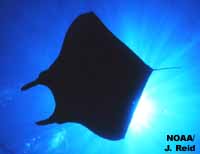.jpg) |
A typical fish breathes through gills, has
a body covered with scales, maneuvers using fins and is
ectothermic (cold-blooded). However, unlike other groups
of vertebrate animals, fish are not a single
phylogenetic group, but instead a collection of four
distinct classes. There are two classes of jawless fish,
one of cartilaginous fish, and one of bony fish. Most
fish live in either freshwater or the sea for their
entire lives, while a few, known as anadromous fish,
spend part of their lives in freshwater and part of
their lives in salt-water. Fossils suggest the first
fish appeared nearly 500 million years ago, with fish
being the first animals to evolve moveable jaws nearly
440 million years ago.
With their streamlined bodies fish are well adapted
to travel and live in the water and most species breathe
using gills to extract needed oxygen from water. While
most fish lay eggs and provide their young with little
if any parental care, some do provide extensive parental
care and a small number give live birth.
|
|
|
Jawless Fish
First appearing more than 500 million years ago, jawless
fish are the oldest group of fish. While history suggests
there were once many types of jawless fish today there are
just two - hagfish and lampreys. Both species have
elongated bodies, smooth, scaleless skin, and a jawless mouth.
There is no bony skeleton in jawless fish, instead a single
cartilaginous notochord runs the length of the body.
Gills are almost porelike openings near the head.
Most lamprey spend their adult lives in marine waters,
returning to freshwater streams and lakes to breed.
Young lamprey pass through several larval stages before
becoming adults and heading out to sea. Hagfish live and breed
only in marine waters and young a miniature versions of the
adults.
|

This sea lamprey illustrates the common
features of jawless fish. A circular mouth, small porelike
gills, and an elongate body.
|
|
Cartilaginous Fish
The most prominent group of cartilaginous fish is the
sharks which have been made famous by deadly encounters with
surfers and the occasional swimmer. There are a total of three
types of cartilaginous fish: sharks; skates and rays; and
chimaeras. What these groups have in common is a body filled
with structural cartilage instead of bone, teeth that are
replaced through-out their lifetimes and skin that's covered
with tiny, toothlike scales. All cartilaginous fish are
carnivorous - some of the larger sharks are filter feeders
with greatly reduced teeth, but their primary food is
zooplankton and phytoplankton found floating in the water
column. With cartilage instead of bone these fish are
generally more flexible than bony fish. While the majority of
the cartilaginous fish are marine, a few tropical sharks live
entirely in freshwater and some are occasional freshwater
visitors.
|

Despite its size - up to 23
feet across - and menacing appearance, Manta rays are harmless
filter feeders that feed primarily on plankton.
|
|
Bony Fish
The vast majority of the fish - more than 9 of every 10
species - observed today are bony fish. These fish
have light, strong, bony skeletons and flexible fins that
allow these fish to swim with precision. Most bony fish also
have a gas-filled swim bladder that allows them to swim at
precise depths by adjusting their buoyancy. Bony fish have
adapted to live in every type of aquatic habitat from alpine
lakes to deep ocean trenches.
These fish are widely considered to be "advanced"
meaning they have evolved more recently than the other types
of fish. Many species are specially adapted for their niche
and have wildly divergent features. Bony fish range in size
from milimeters in length to as much as 15 feet in the
length. The largest species are swordfish, bluefin tuna,
blue marlin, and sunfish.
|
.jpg)
An oddity of the open ocean, Sunfish are the
heaviest of all fish - weighing up to 4000 pounds - and among
the most prolific with a single female laying as many as 300
million eggs that drift away with the current.
|
![]() |
| Making the first step through education!
|
|

